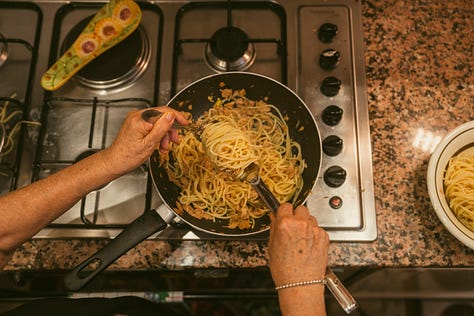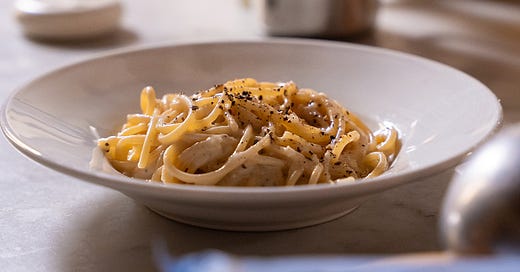Some dishes dazzle with complexity, while others bewitch with simplicity. Cacio e pepe belongs to the latter category. It has just three ingredients that, with a little technique, become something greater than the sum of their parts.
The name means "cheese and pepper," which Roman shepherds carried when cooking in the fields centuries ago. There is no cream, no butter, no shortcuts.
It’s pasta, pecorino, and pepper. From these humble origins, one of Rome's most iconic dishes was born.
Tradition in the Mountains
Long before Rome became a tourist destination, shepherds traversed the Apennine mountains with flocks, moving between seasonal pastures. These journeys required practical food that wouldn't spoil.
What did they carry? Dried pasta for energy, aged pecorino made from their sheep's milk, and black peppercorns, not just for flavor, but for warmth. Pepper's heat-generating properties protected shepherds from cold mountain nights as they watched over their flocks.
With these few ingredients and a pot of water, they created a meal that has endured for centuries.
About Nonna Franca
When Nonna Franca makes cacio e pepe, she isn't just cooking; she treats it as a creative act.
"Cooking is not a burden for me. It's a creative act that relaxes me..a way to be present in the world."
She is originally from Campania but has spent the last 30 years in Monterotondo, a tranquil town near Rome. There, she pays the same careful attention to her dishes as to cultural treasures.
Growing up in a large family where her mother and aunts prepared elaborate meals, Nonna Franca learned that food was about connection. She carries those memories into her own kitchen, where tradition meets creativity.
Like her restoration work, cooking requires patience, precision, and respect for what came before.
About the Recipe
Nonna Franca’s Cacio e Pepe (Serves 4)
⏲️ Cooking Time: 20 minutes
Shopping List:
1 box Pasta (Spaghetti)
Salt
Olive Oil
Black Pepper
300 grams Grated Pecorino
Pasta Water
How To Make It
Step 1: Boil the Pasta
Bring a pot of water to a boil. Add a small amount of salt, keeping in mind that pecorino is already salty. Add the spaghetti and cook for about 10 minutes, or until al dente.
Step 2: Toast the Pepper
While the pasta cooks, grind fresh black pepper directly into a dry pan. Toast it over low heat for a few seconds to release its aroma. Then add a splash of pasta water and a small drizzle of olive oil to help emulsify the flavor.
Step 3: Make the Cheese Cream
In a separate bowl, mix grated pecorino with a bit of warm (not hot) pasta water. Stir vigorously until it forms a smooth, creamy consistency. Avoid using boiling water—it can cause the cheese to clump.
Step 4: Finish Cooking the Pasta
Transfer the spaghetti directly from the pot to the pan with the pepper and water. Toss over low heat for the final minute of cooking so it absorbs the flavor.
Step 5: Combine and Serve
Turn off the heat and transfer the pasta into the bowl with the pecorino cream. Toss vigorously to coat the pasta evenly. Plate and top with extra pecorino and freshly ground black pepper.
Step 6: Mangia, Mangia
Now that you're done, there's only one thing left to do!
Nonna’s Notes
Temperature matters. Never add cheese to boiling water or a hot pan. It will separate and become rubbery instead of creamy.
Fresh is best. Always grind your pepper just before using. Pre-ground pepper loses its essential oils and aroma.
The right cheese is key. Pecorino Romano is traditional, but if you want it to melt properly, make sure it's not too aged or dry.
Pasta water is magic. The starchy water is what creates the creamy sauce without adding cream. Always reserve some before draining.
Work quickly. Once your pasta is ready, you have a small window to combine everything while the temperature is perfect.
The Secret in the Simplicity
What makes cacio e pepe so special is what's not in it. No garlic, onions or herbs. Just the pure flavor of quality ingredients allowed to shine.
Tavern owners in ancient Rome supposedly served the dish intentionally dry, forcing patrons to order more wine to wash it down. Whether that's true or not, the dish had staying power. From shepherd's necessity to Rome's trattorias, cacio e pepe has survived centuries because it's both humble and extraordinary.
It reminds us that the most enduring pleasures are often the simplest.
What We're Making This Week



What three-ingredient dish do you swear by?
Reply to this email with your story. We might feature it in an upcoming newsletter.
We add recipes to our collection weekly, drawing from kitchens across Italy's diverse regions and nonnas. 👌 Join our community and share your attempts at cacio e pepe with @cookwithanana. We'd love to see what you make!
Until next week,
Buon appetito!










